-
Car Reviews
- All reviews
- Midsize SUVs
- Small cars
- Utes
- Small SUVs
- Large SUVs
- Large cars
- Sports SUVs
- Sports cars
- Vans
Latest reviews
- Car News
-
Car Comparisons
Latest comparisons
- Chasing Deals
By adding the Hilux’s 2.8L engine and automatic transmission, the 70 Series is now pitched at a broader range of buyers, but is it better than the tried-and-tested V8?
Death, taxes and the fact that Toyota’s 70 Series Land Cruiser will get you into the bush and back home again without breaking a sweat: these are the three promises we Aussies are given in life.
It’s a promise that Toyota has done its very best to keep in the 39 years this iconic piece of motoring has been on sale, and it’s done so by keeping this 4×4 basic, but undeniably effective.
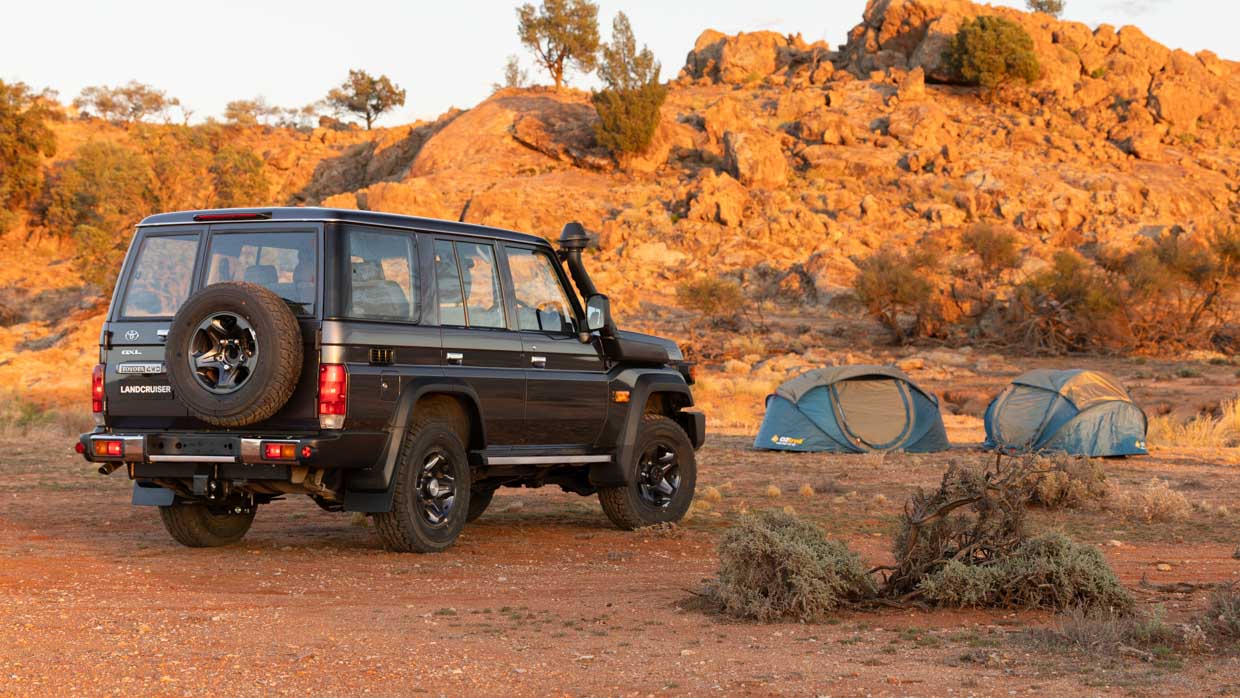
Is it too basic though? Some say so, including, we’re told, fleet buyers who have begun to move away from the 70 Series towards the Hilux due to a series of reasons, if primarily due to its lack of an automatic transmission.
So it’s hardly surprising then that back in 2017 Toyota kicked off a major development process to rectify this issue, in effect killing two birds with one stone by shoehorning in the Hilux’s 1GD 2.8L turbo-diesel four-cylinder and its accompanying six-speed automatic into the 70 Series.
See, as the years have rolled on, many fleets have made concrete rules against manuals and/or V8s, while others have gone to great pains to make an exception for the 70 Series.
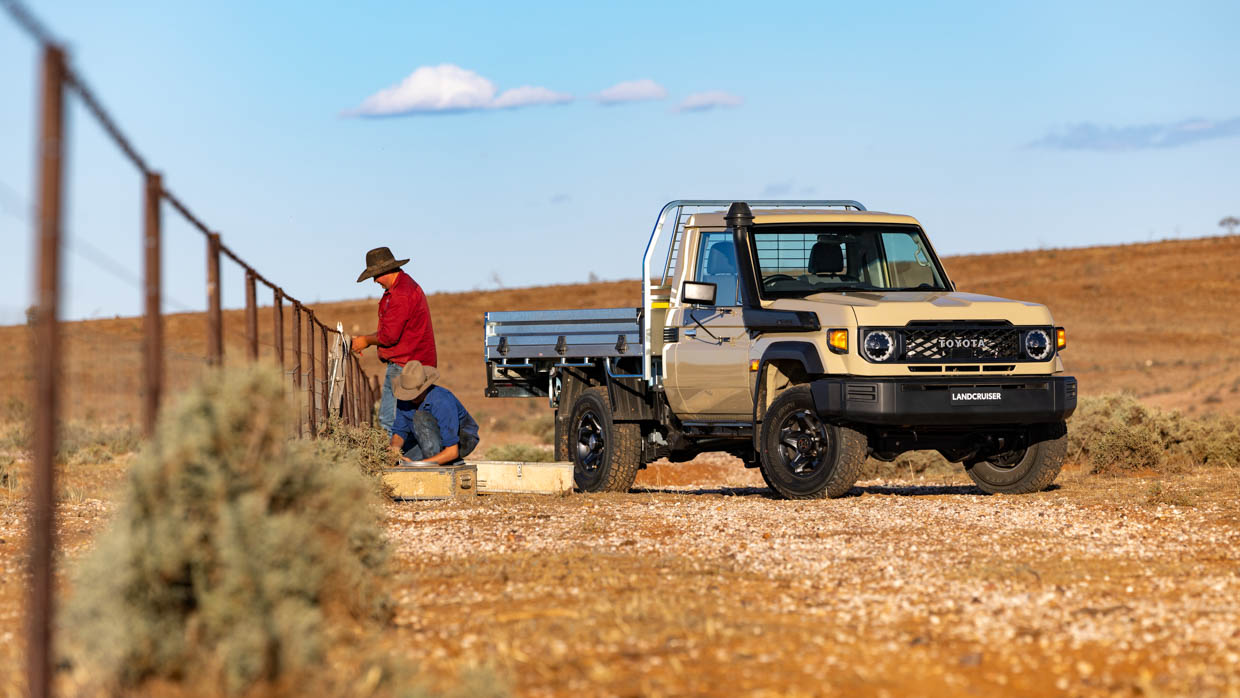
But even for private buyers, there is a lot here to love here. The 2.8L diesel is $4100 cheaper, more fuel efficient, has more torque, is lighter and, as a result, the four-pot 70 Series has a greater payload than the V8.
Is all of that proof that it’s better? Not necessarily. What keeps the 70 Series going after 39 years isn’t its rugged looks or even reputation for reliability. But, really, the keyword is ‘dependability’.
Toyota went to great pains to explain that the 70 Series is owned by more than just that tailgating-tosser down the road from your house, who has fitted more accessories than an ARB distribution centre strapped to his rig and rocks a set of four very clean tyres.
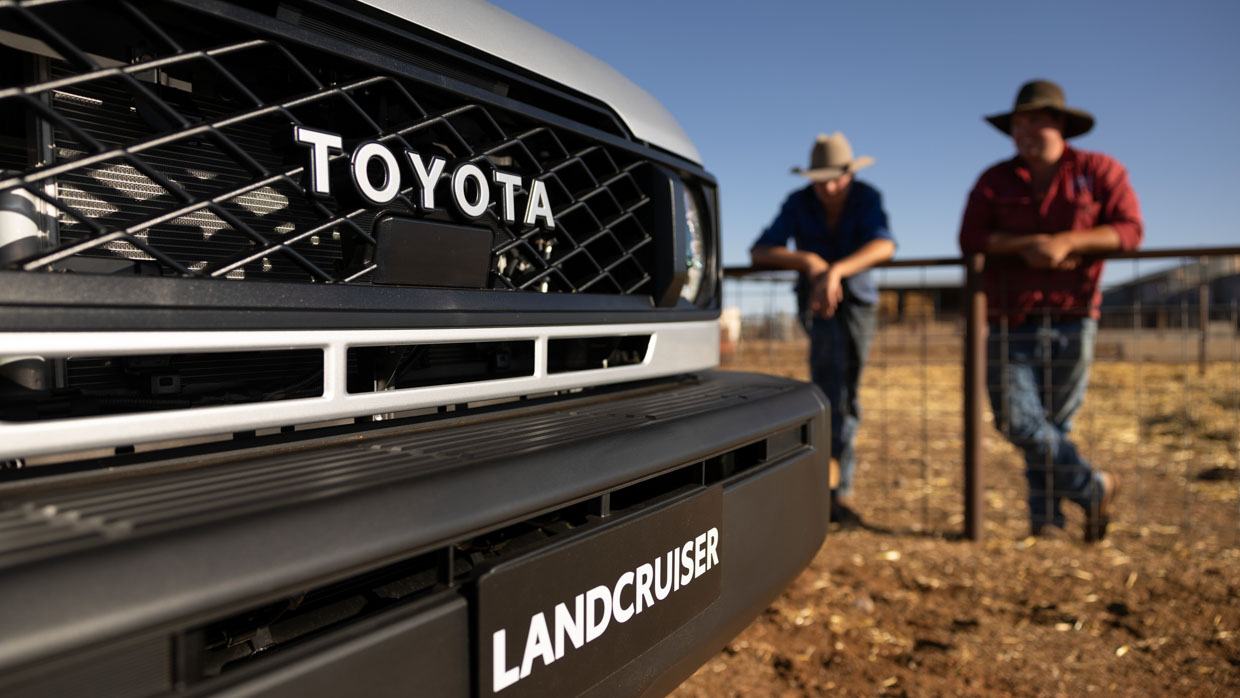
For many, the 70 Series makes the impossible possible in some of the most remote and punishing parts of our country.
While careful not to inadvertently label its other models such as the Hilux unreliable by comparison, Toyota touted its ‘no road’ capability as a point of difference. It means that the 70 Series doesn’t just tackle off-road tails, it makes them.
Marketing speak? Yeah, maybe. A porky pie that’s lasted four decades isn’t a bad effort though is it?
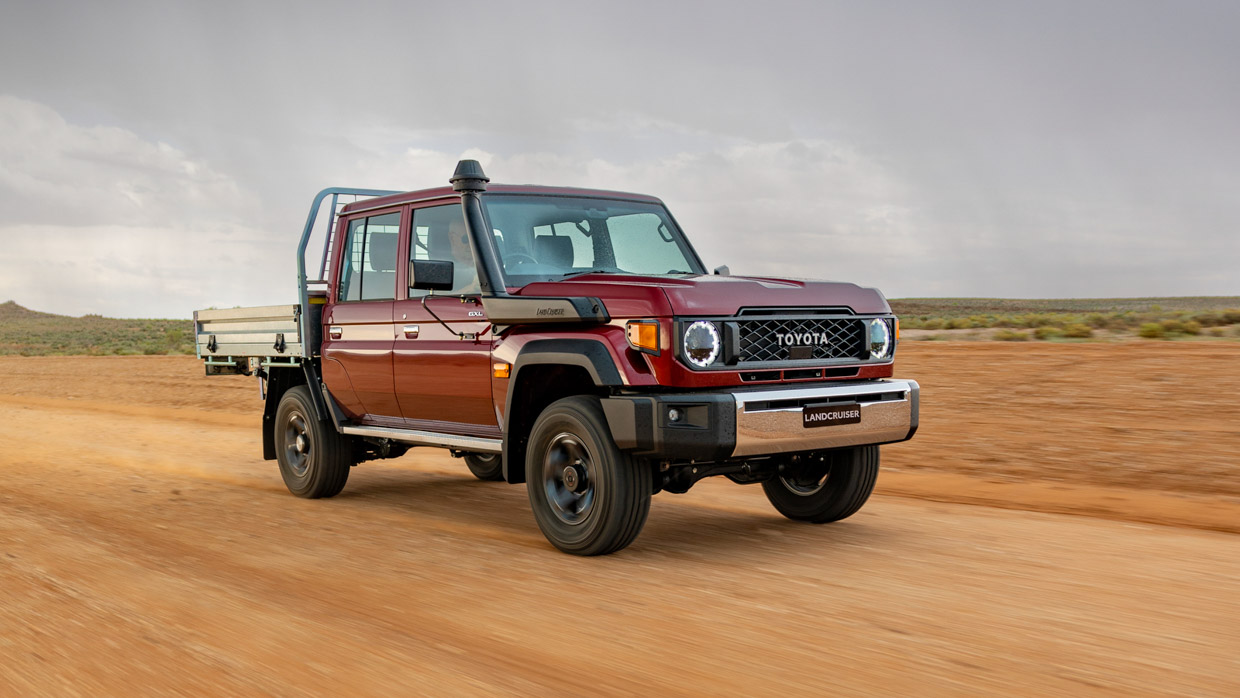
Toyota kicked off the development for this update back in 2017 with Australia the only country outside of Japan where work was undertaken. Surprisingly, but perhaps less so when you realise that one in five 70 Series Land Cruisers sold are to Australian buyers.
Furthermore, the five best-selling years for the 70 Series have only come very recently, in 2018 and between 2020 and 2023. So while it’s no secret that 70 has flaws, it’s also pretty clear most buyers couldn’t care less.
So why muck with a good thing? Toyota says there has been a growing need for that automatic option and although senior executives refused to mark a retirement date, a greater focus on emissions standards around the world and in Australia has to mean the life of the much-loved but heavy-emitting V8 is coming to an end.
In addition to the new engine option, Toyota has updated the look with a 40 Series-inspired front facia, updated parts of the interior and added some safety equipment.
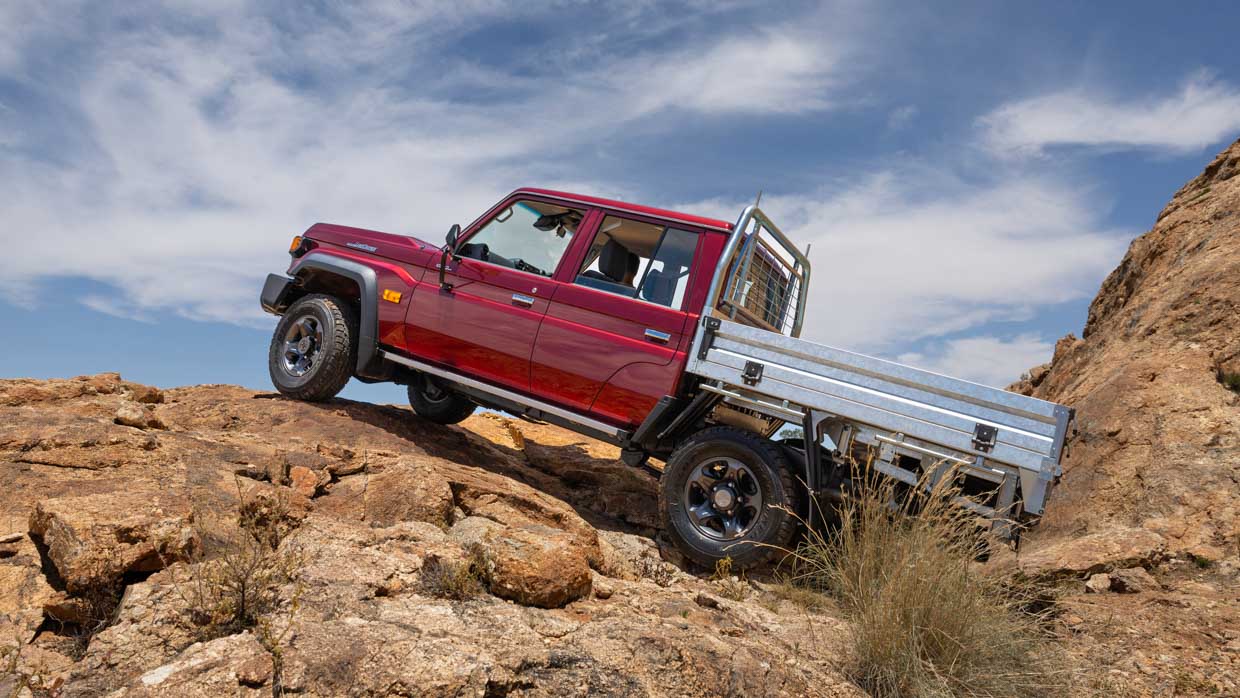
But there’s also a lot they haven’t done.
Beach-loving folk will be saddened to hear the rear track still hasn’t been fixed to match the front, after it was widened to fit the V8 back in 2007. Also, everything bar the single-cab ute is fitted with just two airbags.
So has the updated 70 Series Land Cruiser range simply done the bare minimum or is this latest update, and the new 2.8L a game changer for this icon? Let’s find out.
The 70 Series Land Cruiser range starts at $75,600 before on-road costs for the 76 Series WorkMate wagon, which is the only grade/bodystye combination restricted to the four-cylinder, everything else is available with both engine options.
As before, the 70 Series is available in the 76 Series wagon, 78 Series Troop Carrier, or the 79 Series single and dual-cab ute options.
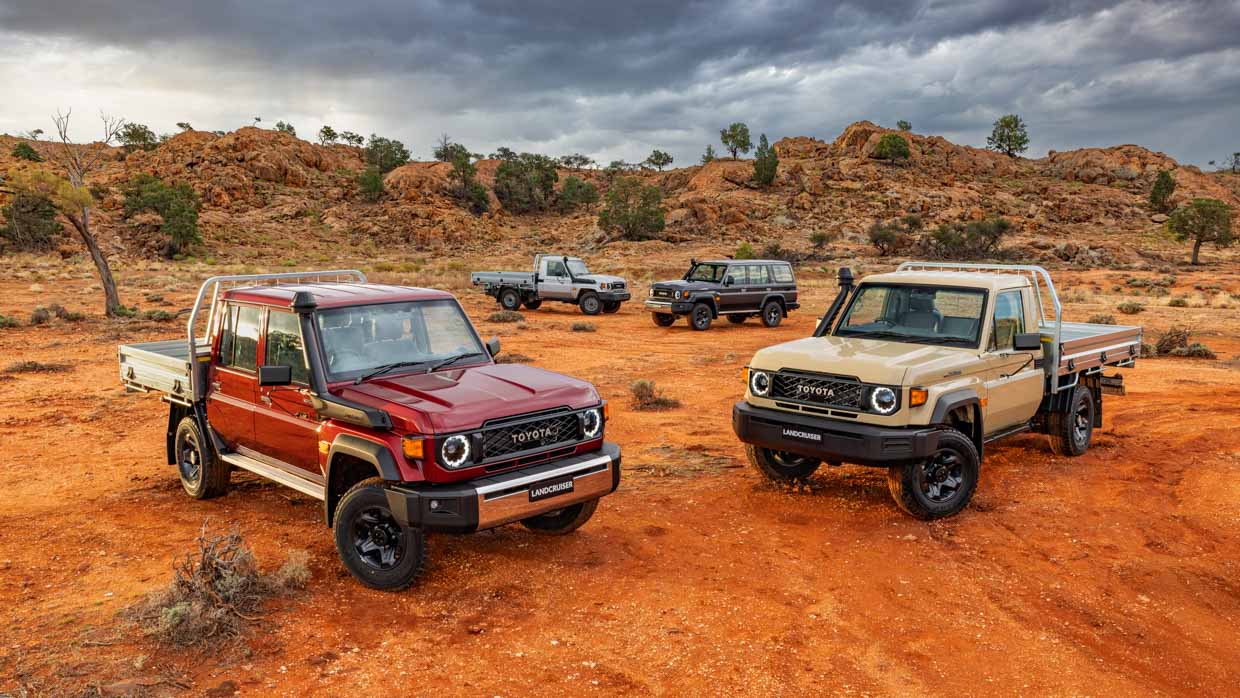
Starting with the WorkMate grade, the 70 Series includes the following:
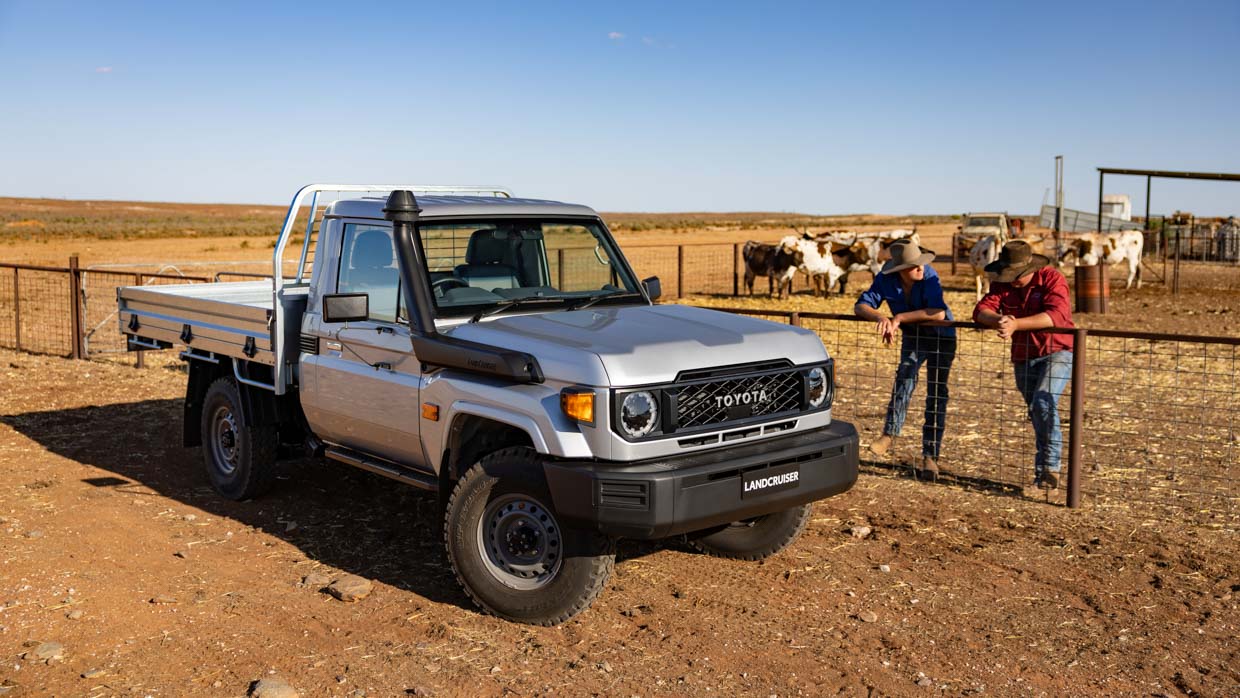
The GX grade is restricted to the single-cab ute, and adds the following:
Stepping up the GXL adds the following features:
The locking front and rear diffs can be added to the GX for an additional $1500 while premium paint costs an extra $675.
Like everything to do with the retro 70 Series, when it comes to driving, what you see is exactly what you get; though the new 2.8-litre turbo-diesel four-cylinder has made life a bit easier.
I’m sure many of you will be very familiar with this engine as it’s found in the Hilux ute as mentioned before, but also the Fortuner and Prado 4WD wagons, in the same 150kW/500Nm state of tune.
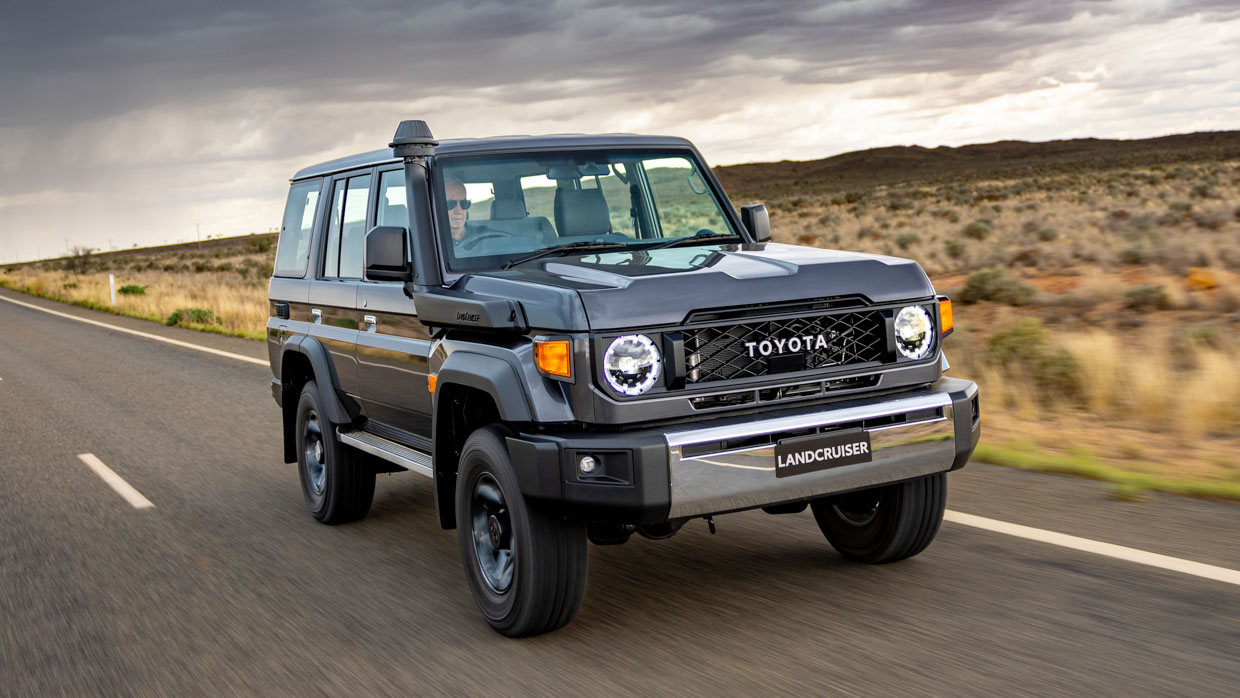
Champions of the 1VD 4.5-litre turbo-diesel V8 will note that this is 1kW less than its 151kW peak, but it’s also 70Nm down on torque at 430Nm.
When it comes to diesels, torque is always the most relevant number and it’s important to note that although the 2.8L has more torque, the peak is across a narrower band of 1600 to 2800rpm, versus the incredibly broad 1200-3200rpm range of the V8.
But from behind the wheel it does feel like you’re getting more torque, more of the time, and the 2.8L isn’t some annoyingly peaky, highly-strung mess you have to adapt your driving style to. It’s not as smooth as twin-turbo units found in the Nissan Navara and Ford Ranger, but it’s pretty good.
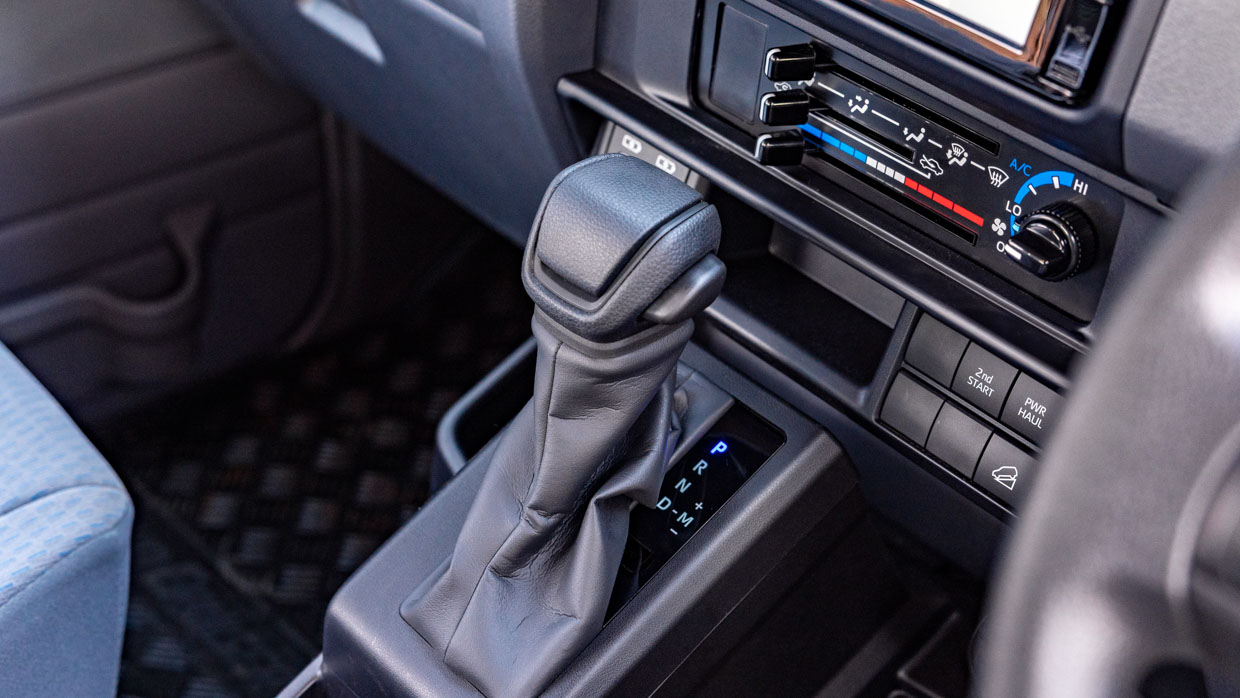
The five-speed paired to the V8 is one of the easiest manuals I’ve ever driven in my life but, even still, the six-speed automatic is a much better option and not just because you don’t have to change gears yourself.
Anyone who has driven a post-2007 model on the highway for any length of time will have found themselves reaching for a sixth year to shift into, as the RPMs sit quite high. Back in 2016, Toyota lengthened the fifth gear of the manual by 15 percent but even still, it sits at roughly 2300rpm at 110km/h, which is quite high.
With an extra gear up its sleeve, the 2.8L hums along at 1700-1800rpm by comparison, a benefit not just to refinement but also to long-distance fuel economy.
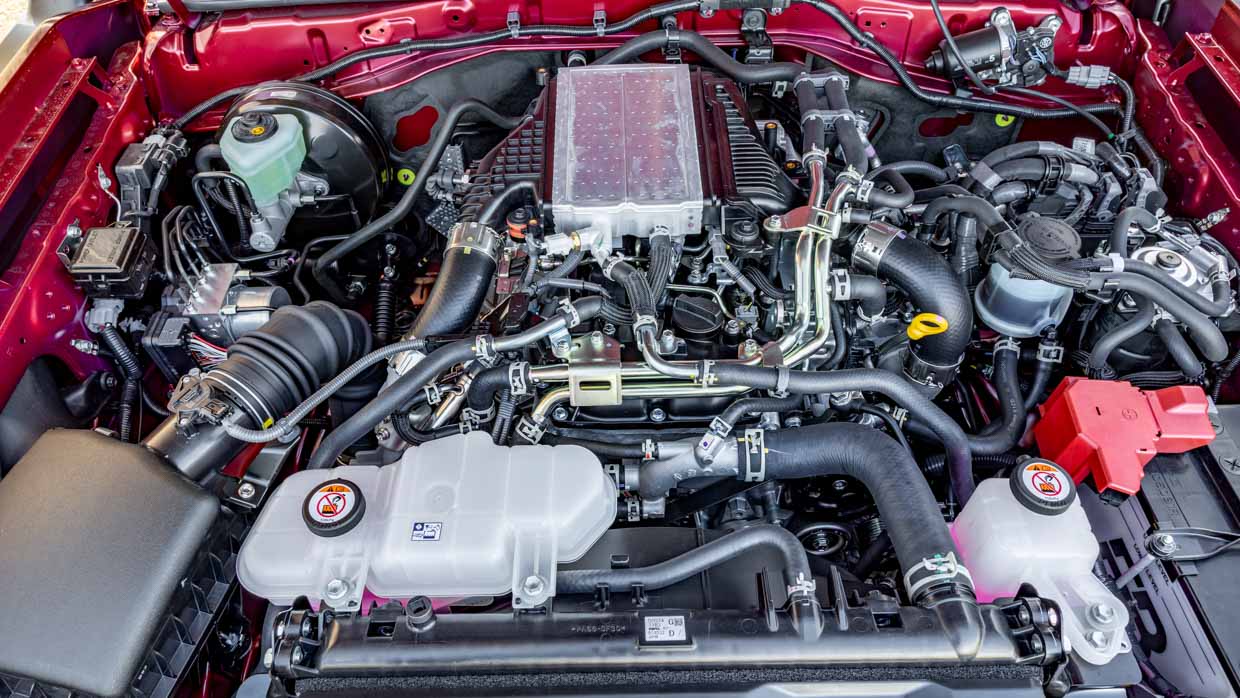
Automatics are nothing new to the 70 Series of course, with the aftermarket for years picking up the tab by offering to fit the 200 Series’ six-speed into its more rugged cousin. Toyota decided not to go down this path, citing less than ideal compromises to durability.
The Hilux’s AC60F has done duty in Toyota’s for years and has no such issues we’re told.
Toyota engineers have also beefed up this engine and transmission combo, with the four-pot scoring a redesigned oil pan made of pressed steel instead of cast aluminium, with other components such as the oil filter moved around to optimised performance and protect crucial parts off road.
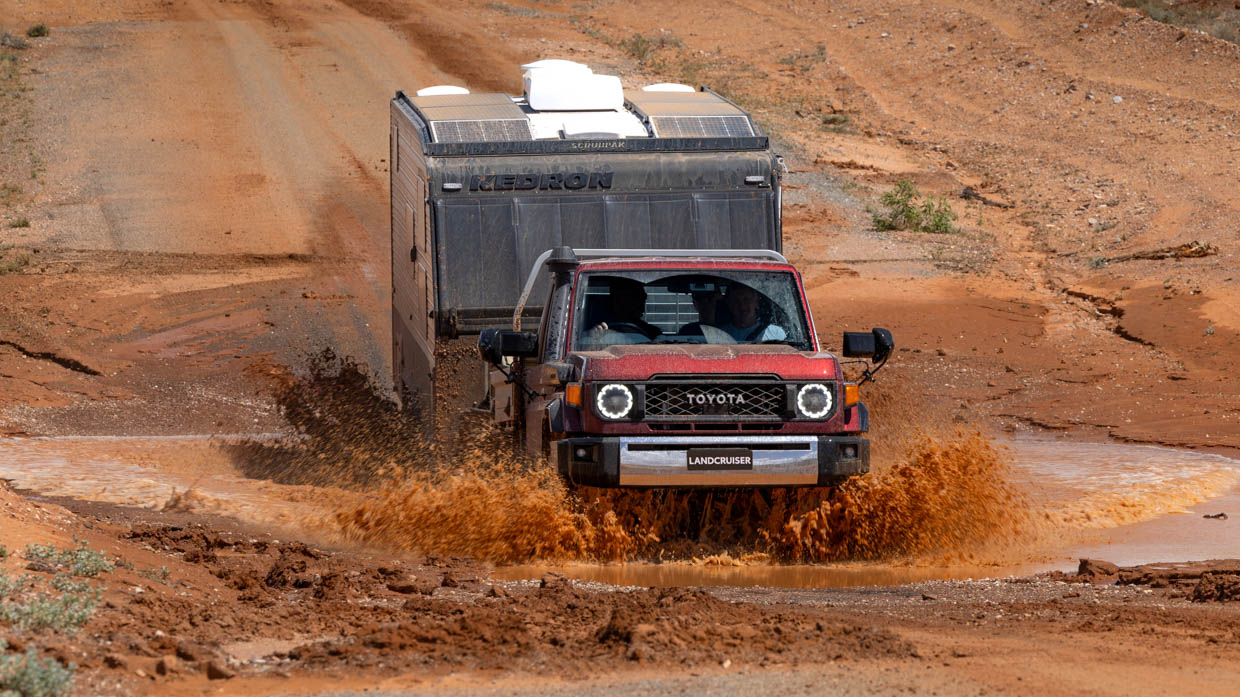
The transmission saw similar upgrades including a larger oil capacity thanks to a deeper oil pan, in a bid to ward off any oil starvation issues when off-roading.
Those interested in heavy towing will be pleased to hear cooling performance has also been improved thanks to the addition of a larger diameter fan and a big intercooler, with further modifications fitted to take stress of the 2.8L from the additional stress of this upgraded equipment.
We undertook a bit of towing during our test drive, pulling the same 3.1-tonne trailer used on the launch of the 165kW/550Nm Hilux GR Sport I drove just weeks earlier.
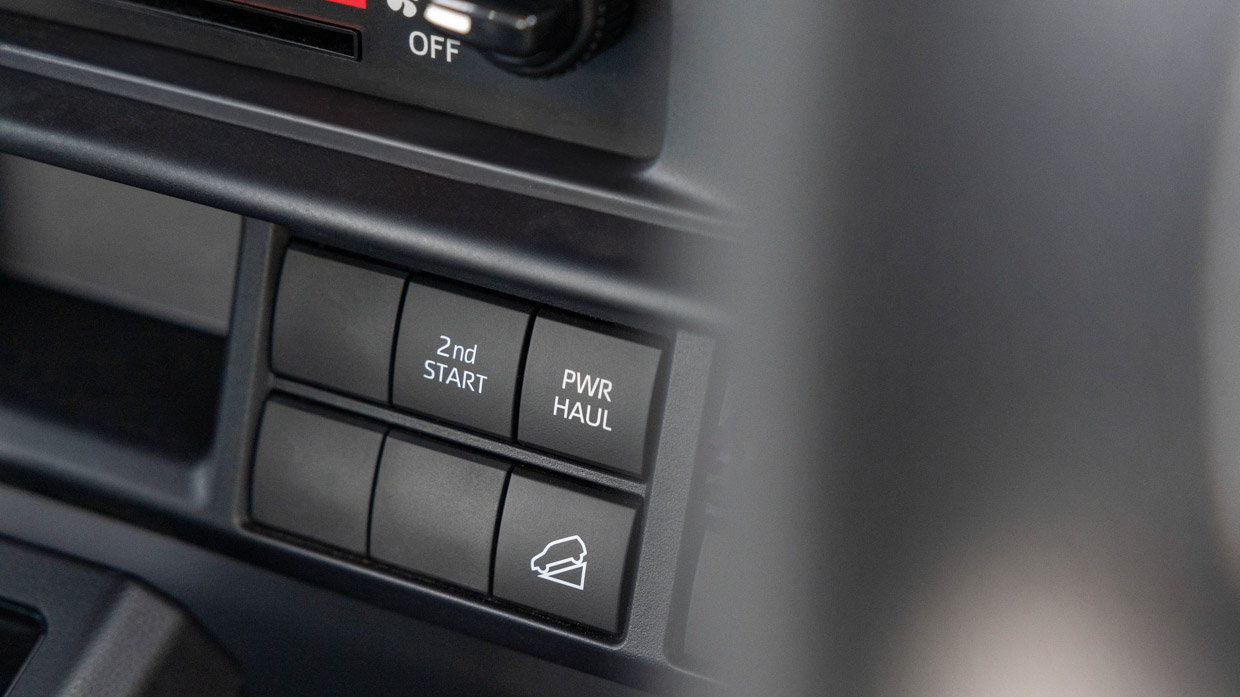
Although in a lower state of tune in the 70 Series, it mattered little, with the 2.8L pulling strong and smooth. The ‘power haul’ model fitted to the automatic also applies a more appropriate transmission calibration.
I don’t need to tell you how good the 70 Series off road, but there have been some improvements here as well with the Toyota engineers fitting a form of hill descent control that proved both accurate and helpful across some seriously tough rocky terrain.
Driving the two engine options back-to-back off road, the auto was naturally the easier one to drive, and I began to appreciate the lack of a clutch pedal as the moguls got deeper. For those wary of a lack of control in the auto, there is the ability to put the transmission into manual model, or simply press the ‘2nd Start’ button to lock into 2nd gear quickly.
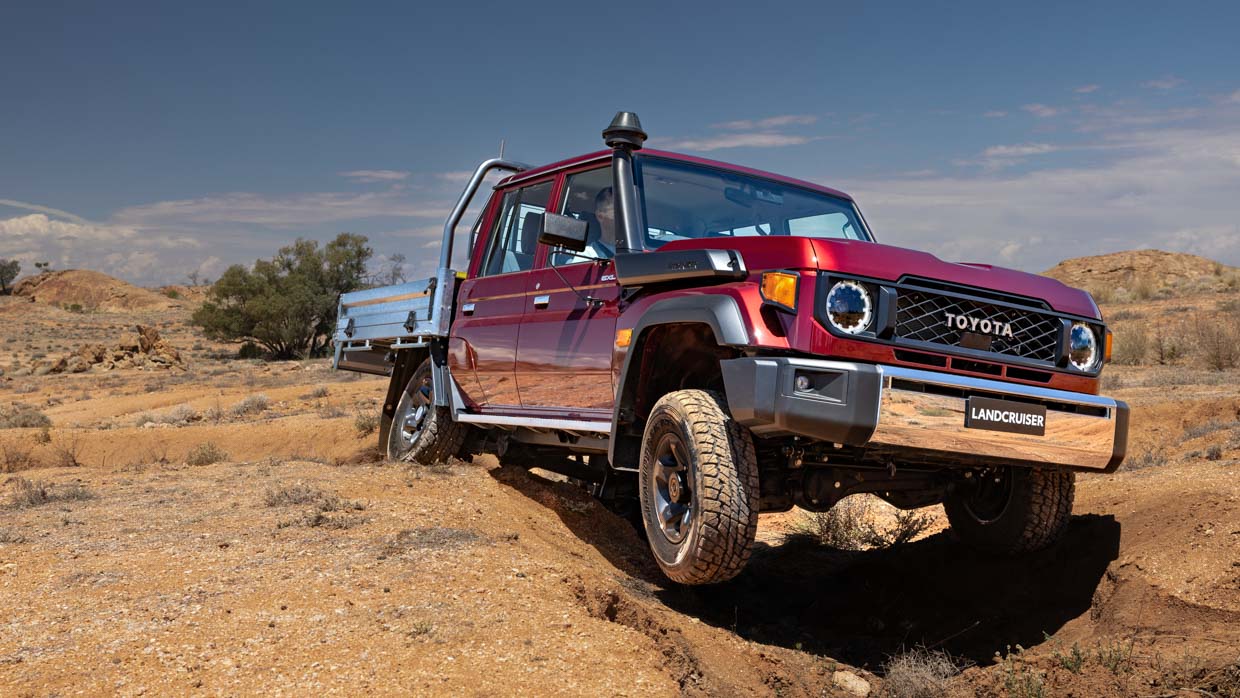
Though of course with that rear track still out of whack, the fishtailing effect was still felt in the soft-sand sections of our drive route.
The 70 Series also remains the only Land Cruiser on sale (including Prado) without a full time four-wheel-drive system, and unlike the part-time system in the Hilux, there is no straight forward system to simply flick between 2H and 4H on the move. But if it ain’t broke, don’t fix I suppose.
During our initial test drive at Broken Hill, NSW, multiple journalists remarked that the 2.8L sounded far more hushed than its other models, though this is likely less to do with the engine and more with the huge amount of the wind noise generated by the 70, particularly from its mirrors.
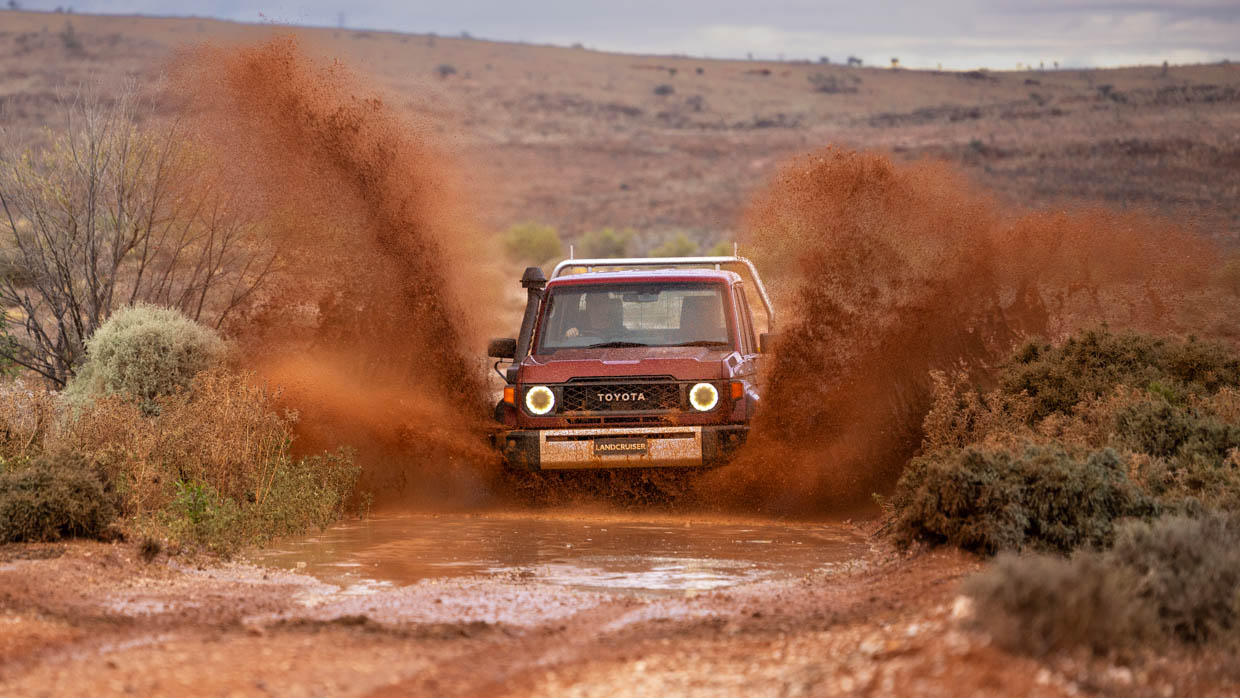
For those who haven’t driven the 70 Series in its 39-year history, just know that it’s a fairly physical machine to wield, an element that has been alleviated a bit in the new automatic-equipped models, but the steering remains heavy and cumbersome.
We drove the 76 Series wagon along with the 79 Series single and dual-cab utes on the launch (though sadly not the loveable 78 Series Troopy) and none are what you might call ‘comfortable’ but the former is definitely the ‘least worst’.
Driving on dirt roads at high speeds requires you to have respect for the nuances of the way the 70 Series drives, with its limited ability to absorb bumps mid-corner without washing out wide, when more modern 4WDs will turn in uninterrupted.
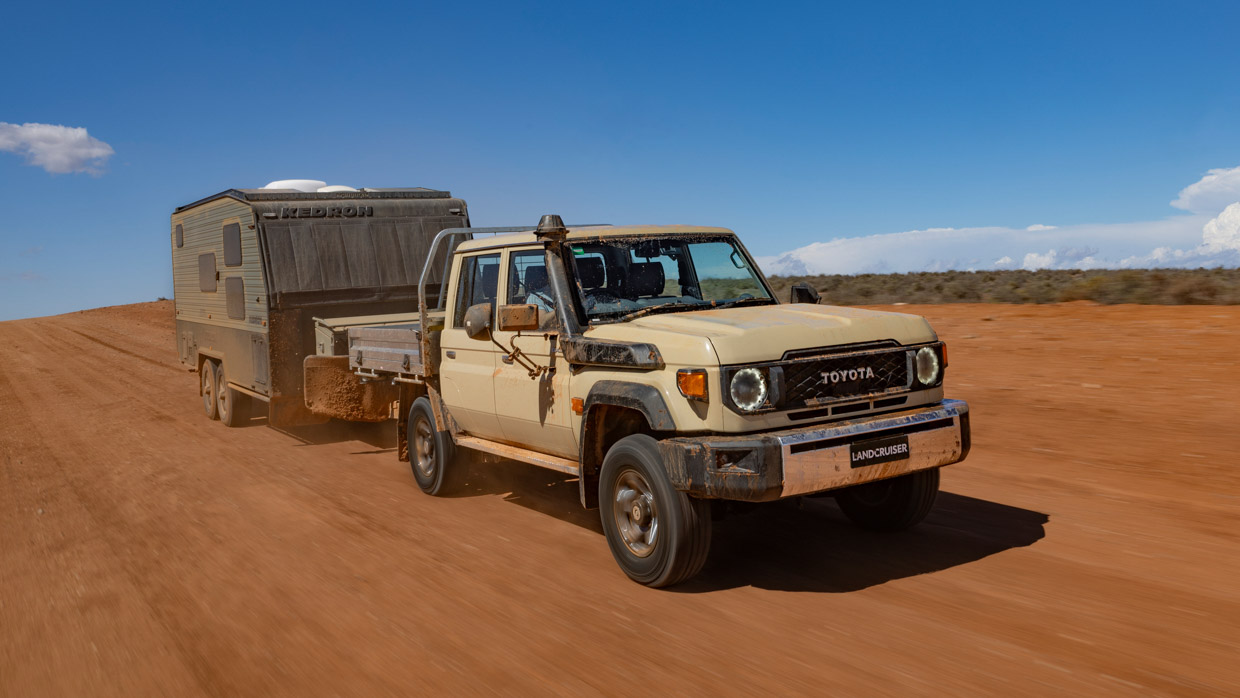
Unlike most 4WD wagons, the 76 employs leaf springs on the rear axle, though there are few leaves per side, resulting in improvements to the ride comfort at the back in exchange for a slightly lower payload.
The braked towing capacity and GWM is identical across the range, at 3500kg and 3510kg respectively. Payload is a little better on models equipped with the 2.8L due to its lower weight, with the four-pot capable of up to 1380kg in the GX single-cab, while V8 models tap out at 1320kg.
Upon opening the Landy’s tinny doors and slamming them shut with a satisfying clang, the biggest change to the interior is quite apparent. Who put a Hilux steering wheel in here?
It’s not a bad thing, with its spread of useful buttons configured to a new 4.2-inch display sitting to the right of the 40-Series inspired instrument cluster, providing a useful readout for the vehicle’s exact speed and fuel economy.
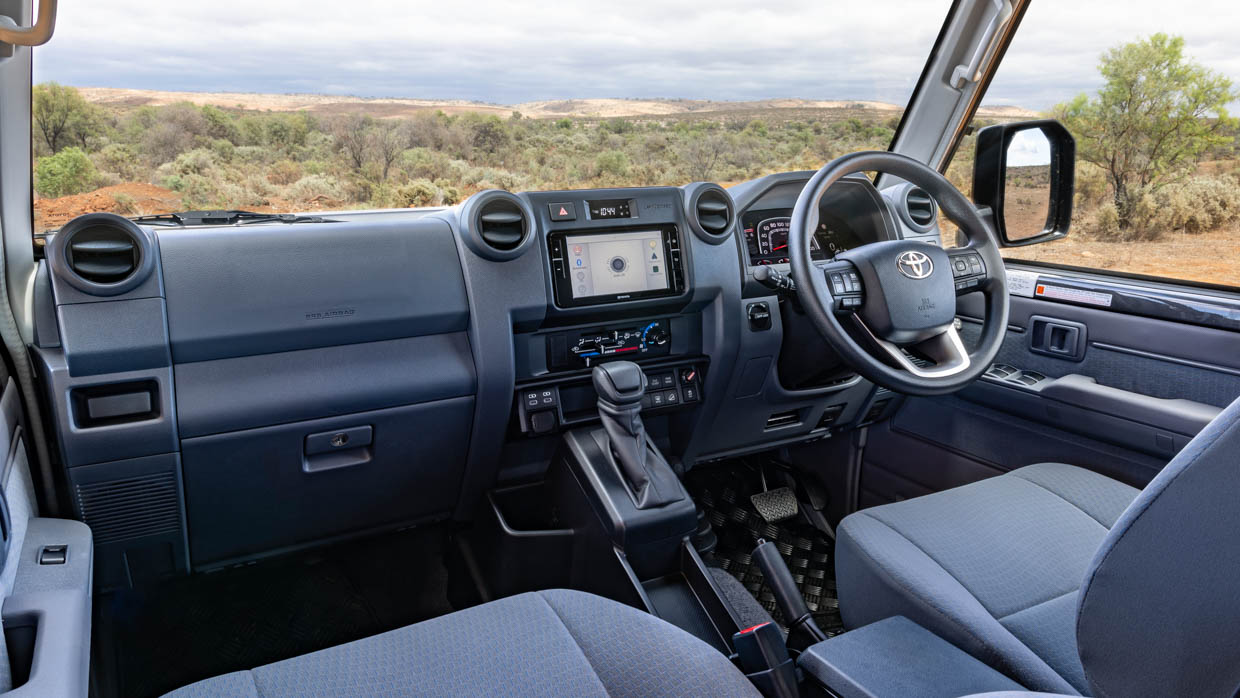
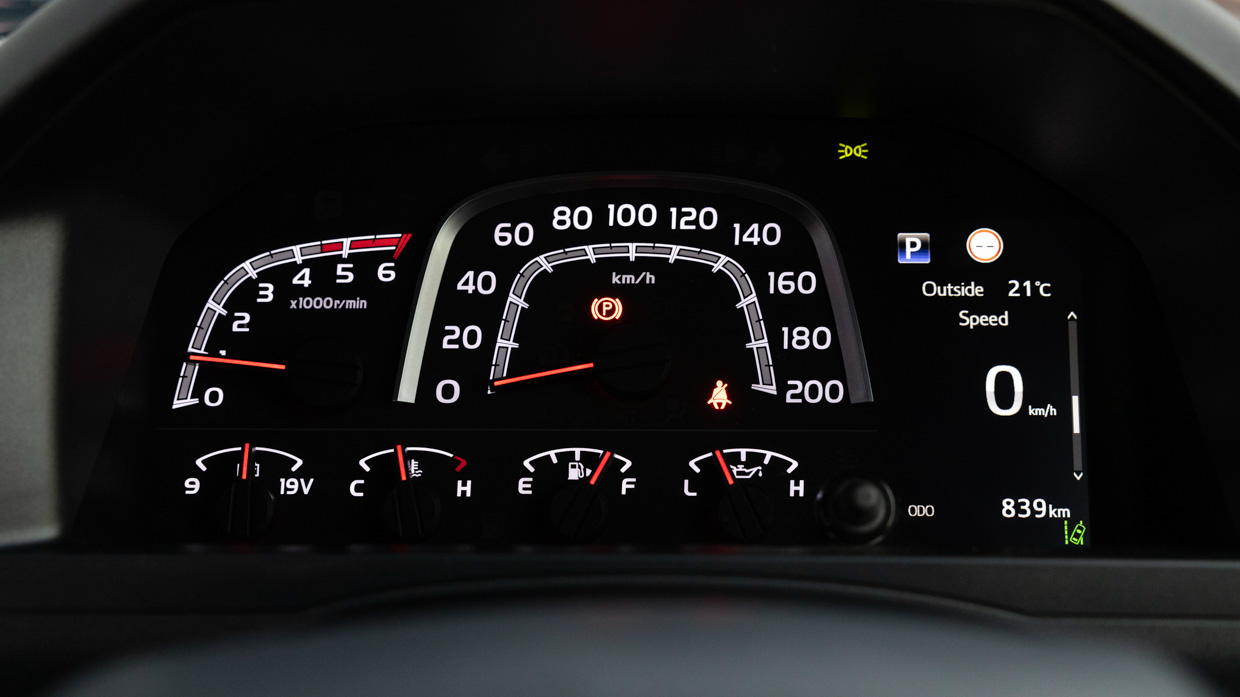
Toyota has bumped up the size of the multimedia screen from 6.1-inches to a whopping 6.7! There’s no more CD player however, as this has been ditched in exchange for that extra 0.6 inches of screen size.
The upgrade to this unit is less about size however and more about what it can do, with wired Apple CarPlay and Android Auto now standard, which is a welcome addition.
Although two USB-C ports have been added to the interior, to to the aforementioned smartphone mirroring software you’ll need to plug into the USB-A port on the side of the screen, which is an absolute nuisance for manual drivers as the cable dangles down in front of the path of the shifter.
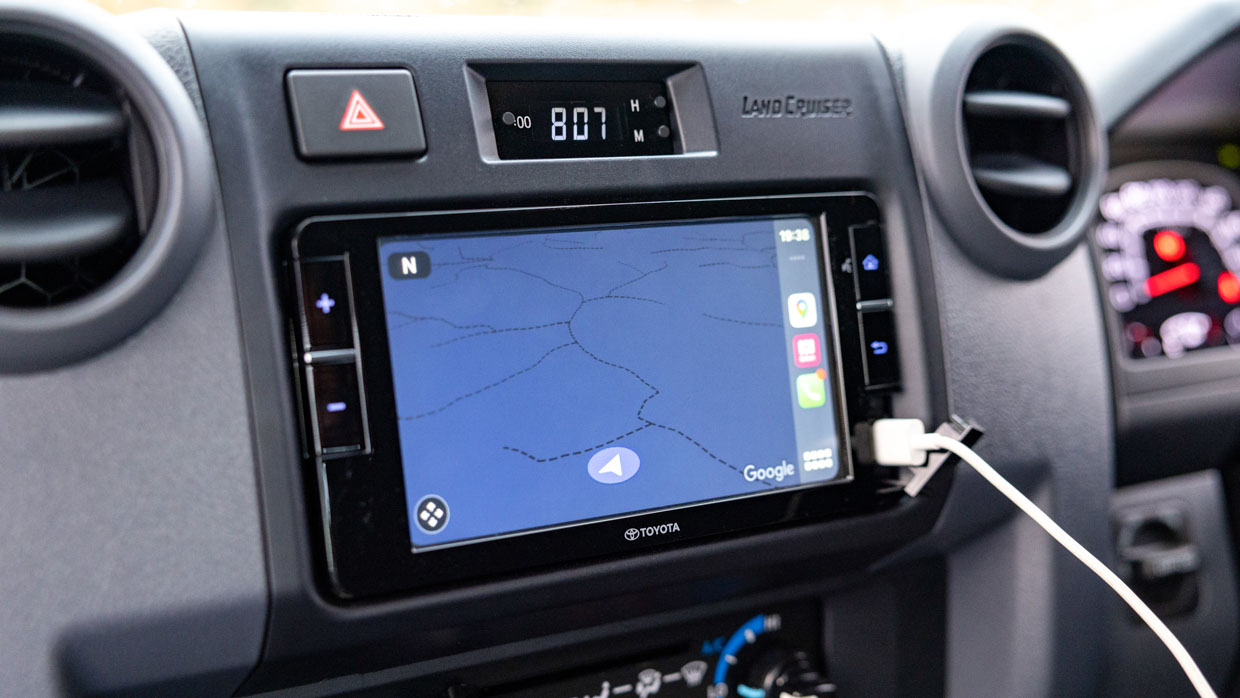
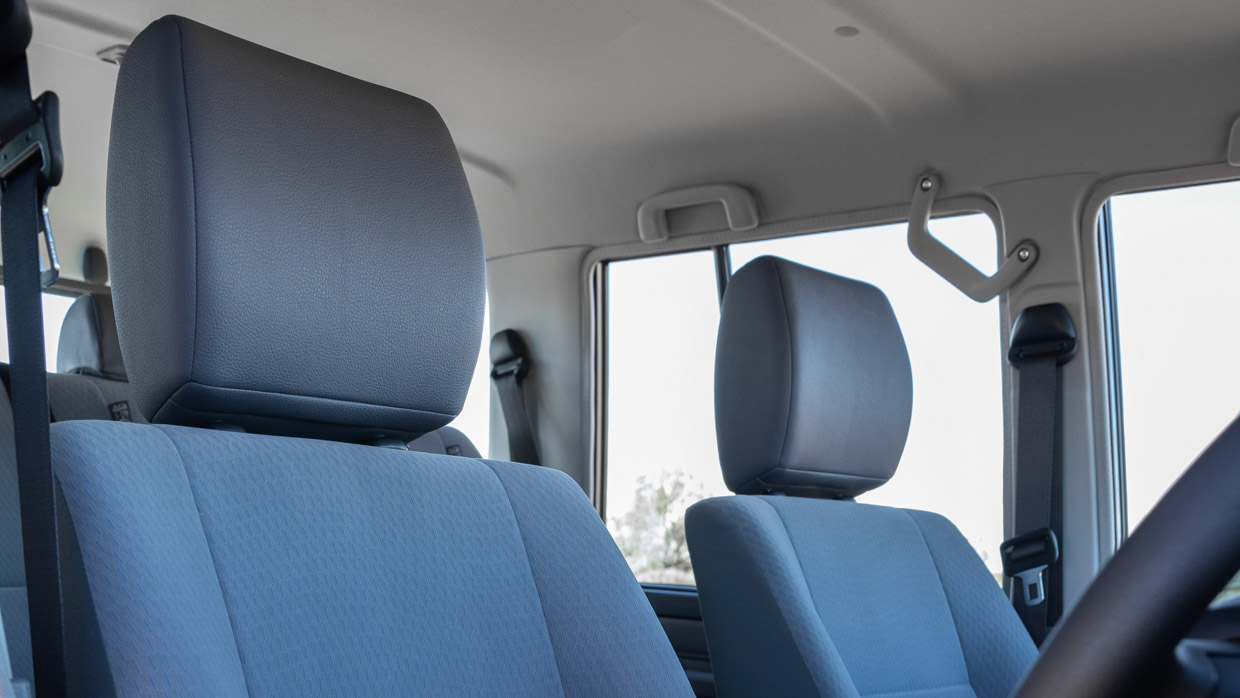
The sound system is still absolutely awful, with a two-speaker system fitted on lower grades and utes, while top-spec models are gifted with a still-bad four speaker setup.
In some good news for the aftermarket industry, the seats of the 70 Series continue unchanged with little in the way of back support and limited adjustment. Having travelled long distances in these before they would be the first thing I would replace.
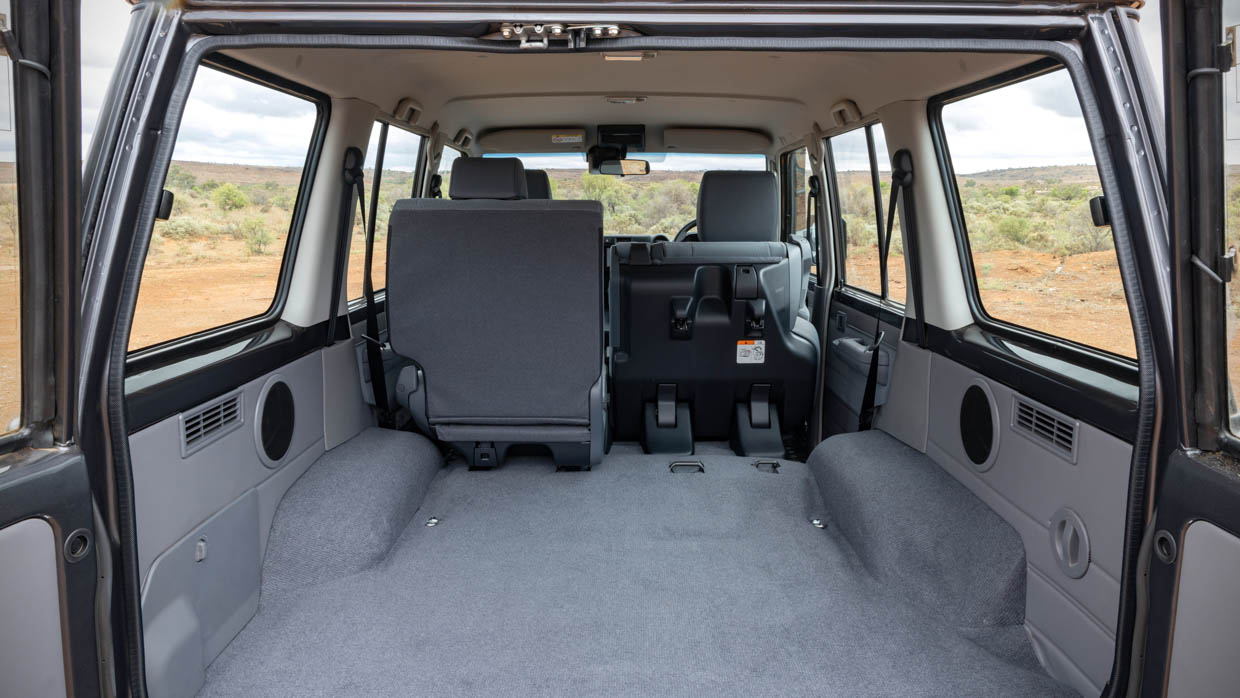
The backseat largely continues unchanged though Toyota has given the wagon variants the ability to fold in a 60:40 split, adding the ability to expand the already huge boot between the seats and the rear bulkhead. The floor sits fairly high and occupants don’t have much room or amenities.
I think it’s likely that many rusted-on 70 Series buyers don’t really expect much safety from their retro 4WD, for many capability is the only question. But it’s also a very expensive retro 4WD and it’s not a lot to ask for both, in your reviewer’s humble opinion.
Toyota has made some improvements here, but the big step was taken at the end of last year, when forward autonomous emergency braking with pedestrian and cyclist detection was made standard across the range.
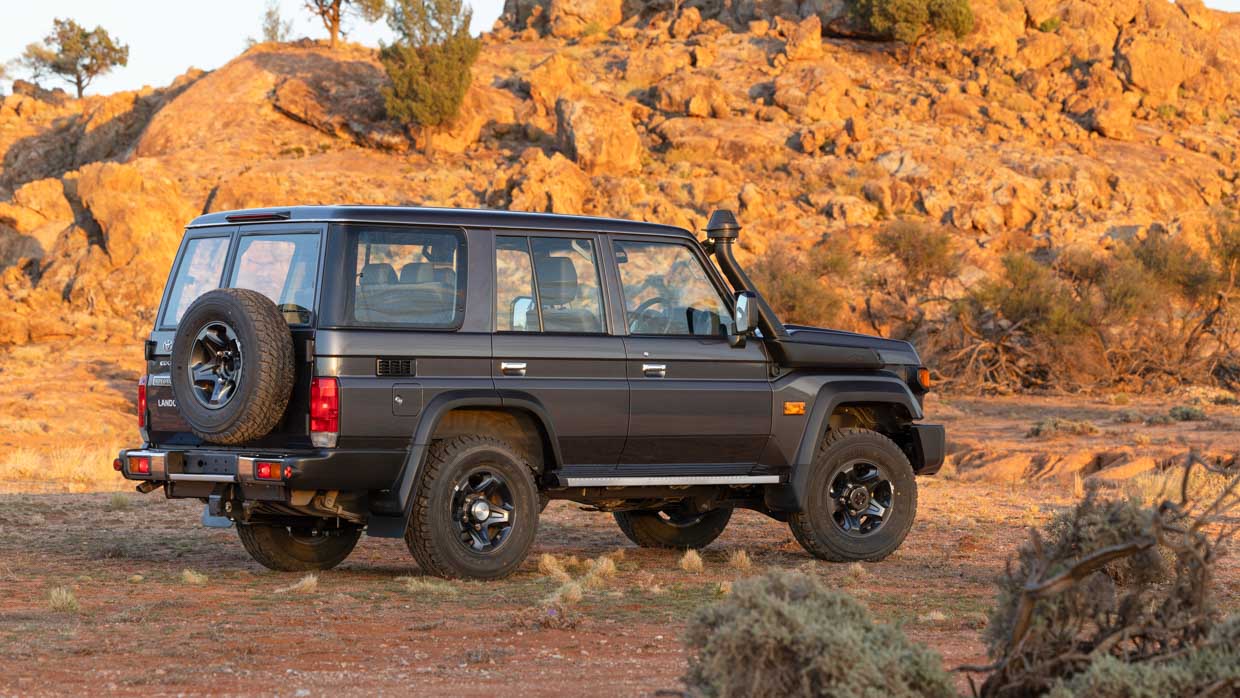
This time around, the technology suite has expanded with speed sign recognition, automatic high-beam, and lane departure alert. The latter can be switched off by holding down a button on the steering wheel but it will return every time you start the car.
Thankfully, it’s pretty good at its job, providing enough bandwidth to move about in your lane when things get a bit more twisty. Throughout our drive, it only bonged at me on two occasions and it was right to do so, offering a polite low-volume tone without any unnecessary carry on.
From here though, the safety pack on the 70 Series range separates into two select classes: the single-cab ute in the first camp; and the dual-cab ute, wagon and Troopy all lumped into the second.
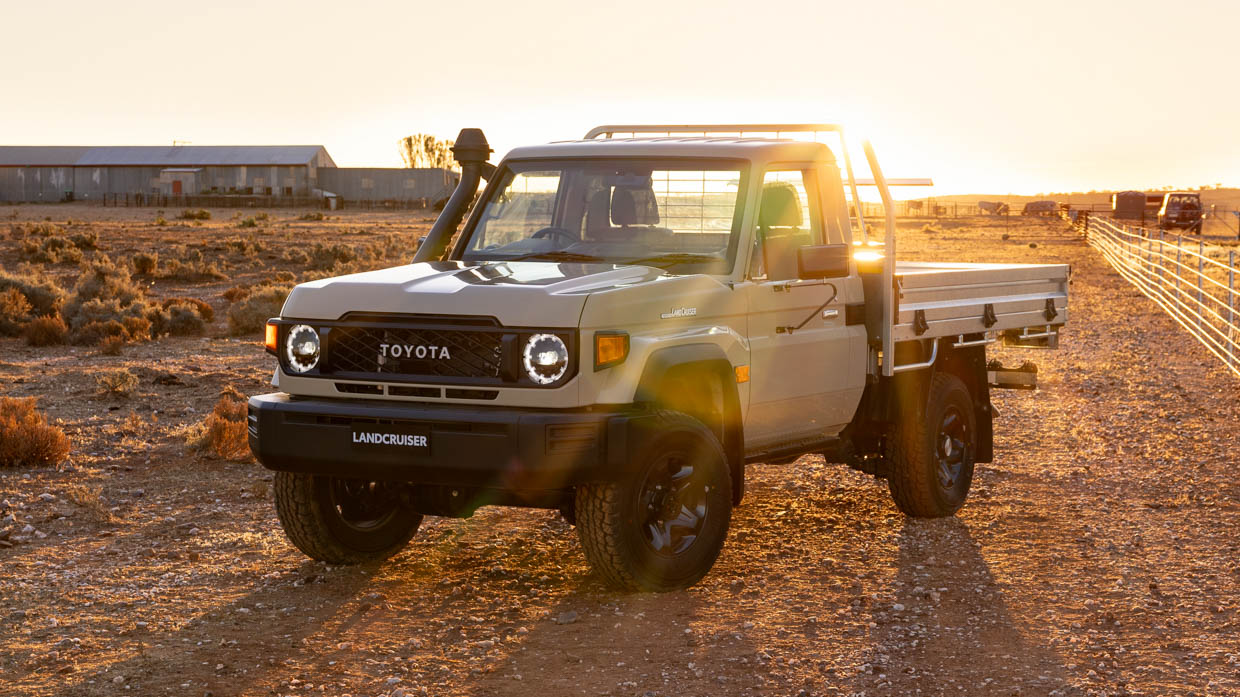
Back in 2016 Toyota upgraded the safety package of the single-cab ute, largely at the behest of mining companies, and added several new safety features but most notably knee- and curtain-style airbags, in addition to the traditional front-on driver and passenger coverage.
As a result, the single-cab ute remains the only variant with a five-star ANCAP rating, which will expire in December of 2023.
In a disappointing move, Toyota has chosen not to upgrade the rest of the 70 Series range with this proven life-saving safety equipment.
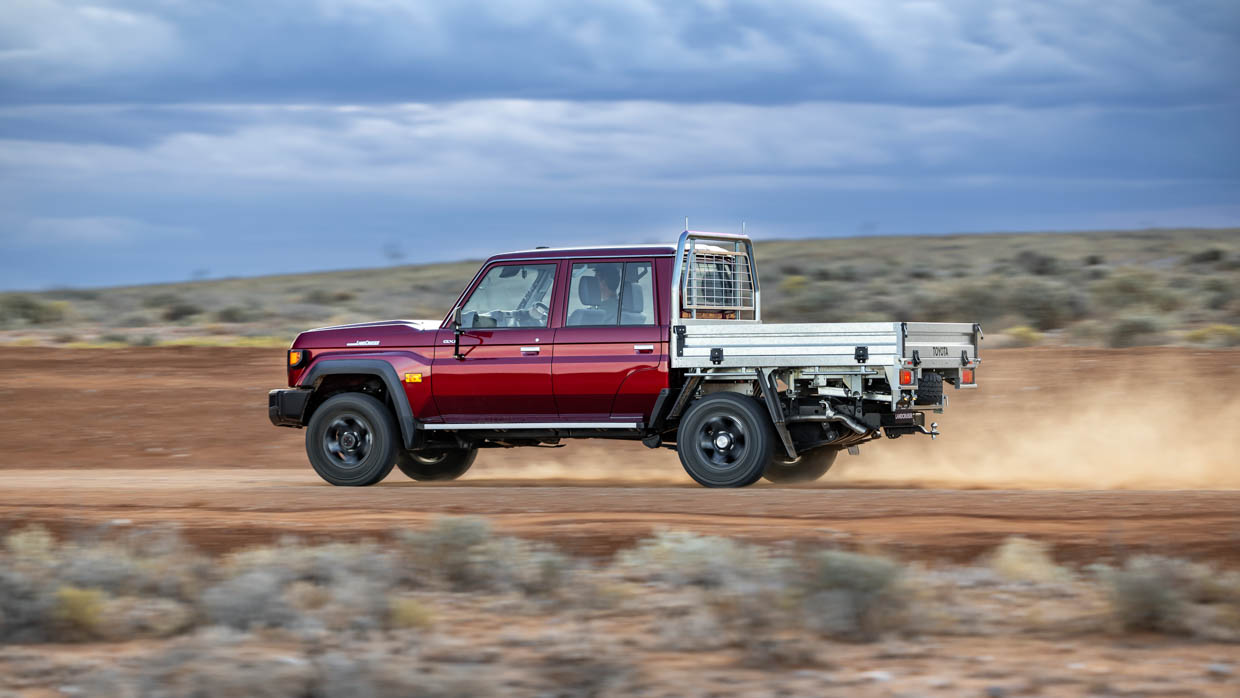
Chasing Cars was told that standardising the safety equipment to the spec of the ute would have required significant re-engineering and resulted in increasing development costs and pushed up pricing, and instead wanted to follow buyer demands and focus on the new drivetrain instead.
This strikes me as a particularly weak excuse. The 70 Series has been on sale for 39 years and will probably hit the mid-century mark before it’s replaced in full.
And with record sales in the last few years, you’d have to imagine there is plenty of bandwidth to justify the investment in basic safety equipment.
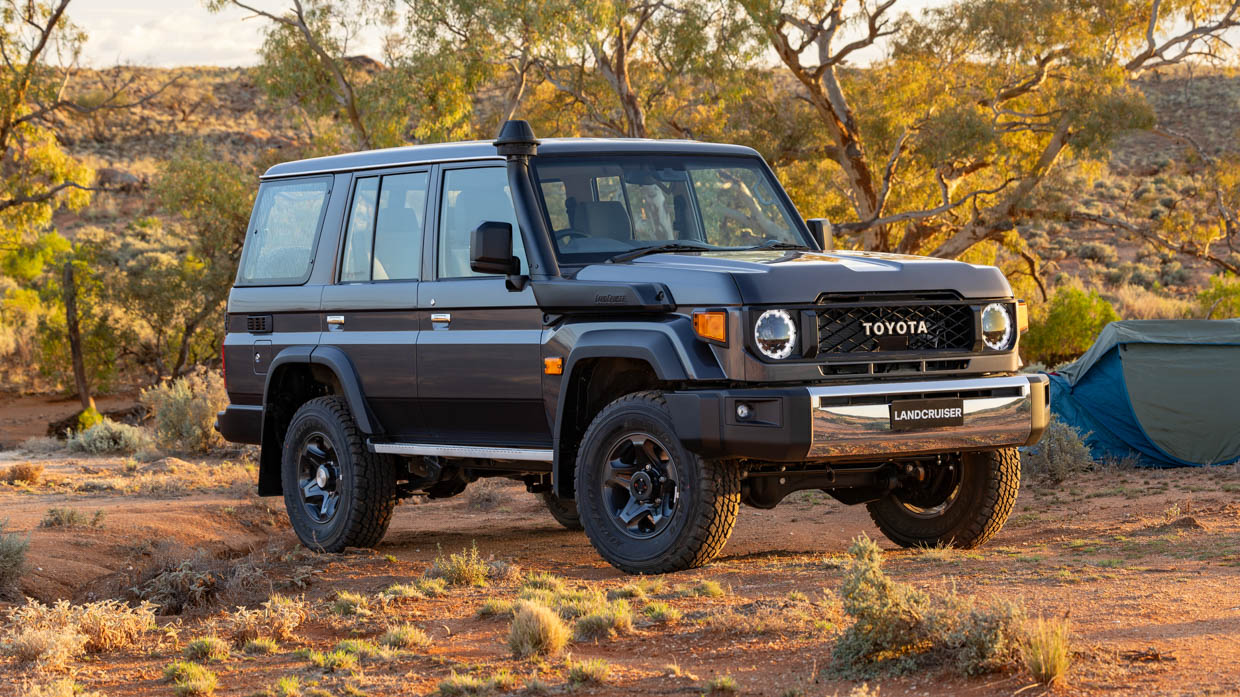
Considering that many products out of Korea see all-new generations replaced every five years with the latest safety equipment, it’s an unacceptable move from a large player such as Toyota.
It’s hard to say how much better an occupant would fare in an accident with this safety technology without full-blown testing, but if I was caught in a rollover at 100km/h on a dirt road in the middle of nowhere, I know which Land Cruiser I’d rather be in.
Of less significance, but still notable, is the lack of ISOFIX points in the second row of the wagon and ute, though for the reasons outlined above, it’s probably best you don’t go putting kids in the back of the 70 anyway.
Toyota offers its standard five-year, unlimited-kilometre warranty on the 70 Series, with service intervals relatively short at every six months or 10,000km. Servicing over five years will see buyers pay $525 for the first 10 services, or $5250 over five years/100,000km.
The brand says the 2.8L four-cylinder is generally 10 percent more efficient than the V8, officially quoting a combined consumption figure of 9.6L/100km and 10.7L/100km respectively.
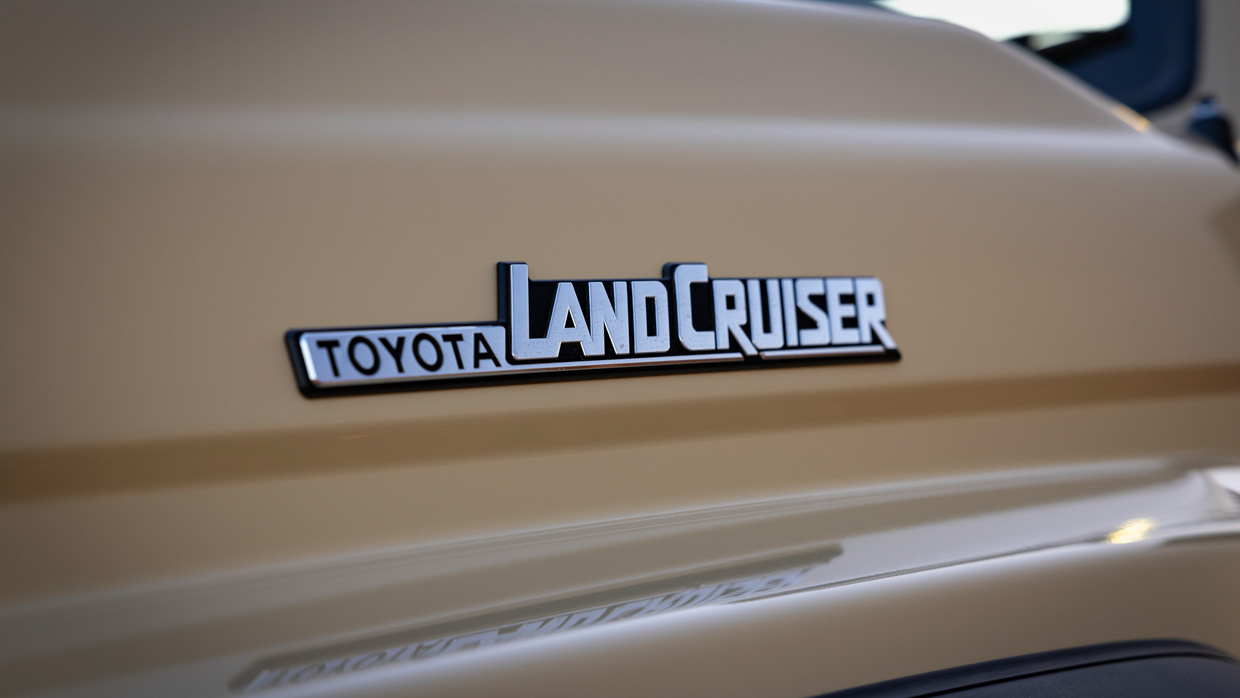
This means the smaller engine not only stands to use less fuel but should also go 140km further on a 130-litre tank of diesel, reaching up to 1354km on paper. The Troopy, with its insanely large 180-litre tank, goes 193km further on paper with the four-pot at 1875km.
We didn’t have time to get concrete fuel figures during our first drive, but Toyota’s claim that the four-cylinder is around 10 percent more efficient does appear to be accurate.
For a vehicle made in Japan, there are few things more Australian than a 70 Series: perhaps Steven Irwin – but then he also owned one too – and I get the feeling that he and other bush-loving folk would have appreciated this latest update to the icon.
It’s an easy thing to love the 70 Series, and I’m of the belief that most Aussies have imagined themselves with one in their driveway at least once, where it would sit only briefly before embarking on the adventure of a lifetime. And many do realise this dream.
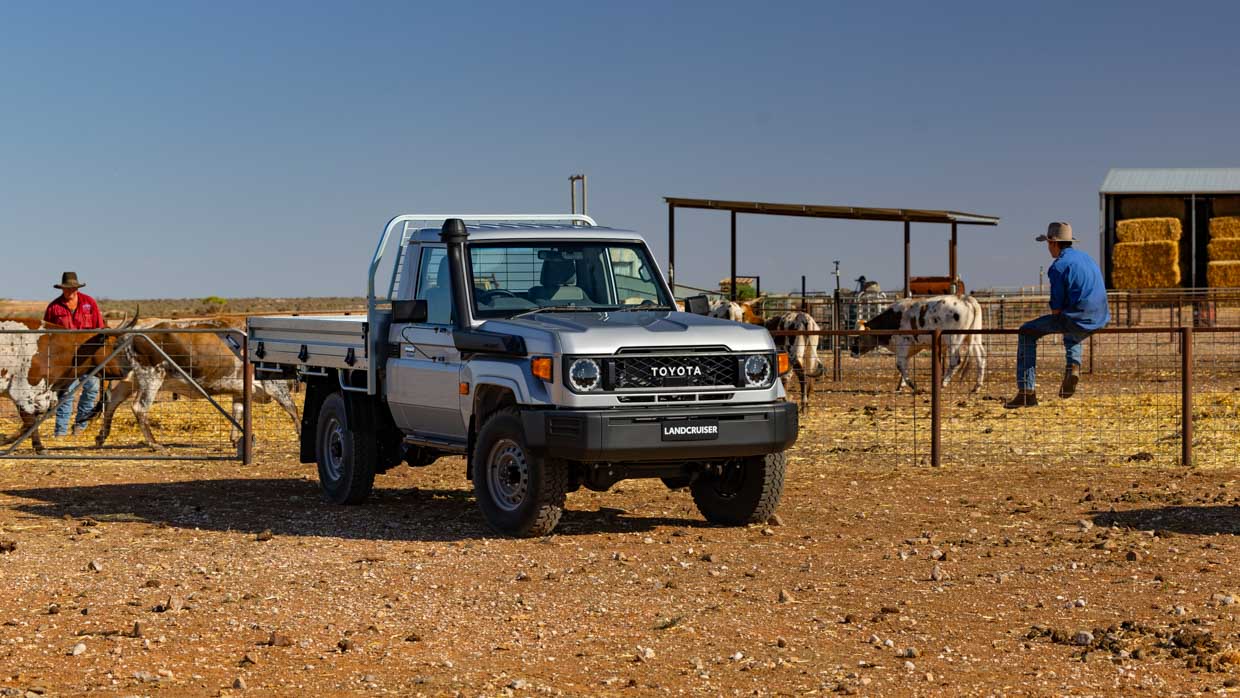
But the 70 Series plays a far more important role in the lives of many in this country, where the additional capability and durability over other 4WD products is of critical importance and it’s great that it exists for that reason.
The addition of the 2.8L has elevated the 70 Series closer to the level of other 4WD products in Toyota’s range. Time will tell if this at all impacts durability but after serving over a decade in the Hilux – a vehicle itself renowned for reliability – this feels like an incredibly safe bet.
What’s more, Toyota’s freeze on V8 sales is still in place, with 12 months’s worth of customer orders still to clear.
And the advantages over the V8 are many: improved fuel economy, increased range, lower purchase price, better payload and greater refinement. By themselves they might be tempting but all together it’s a slam dunk.
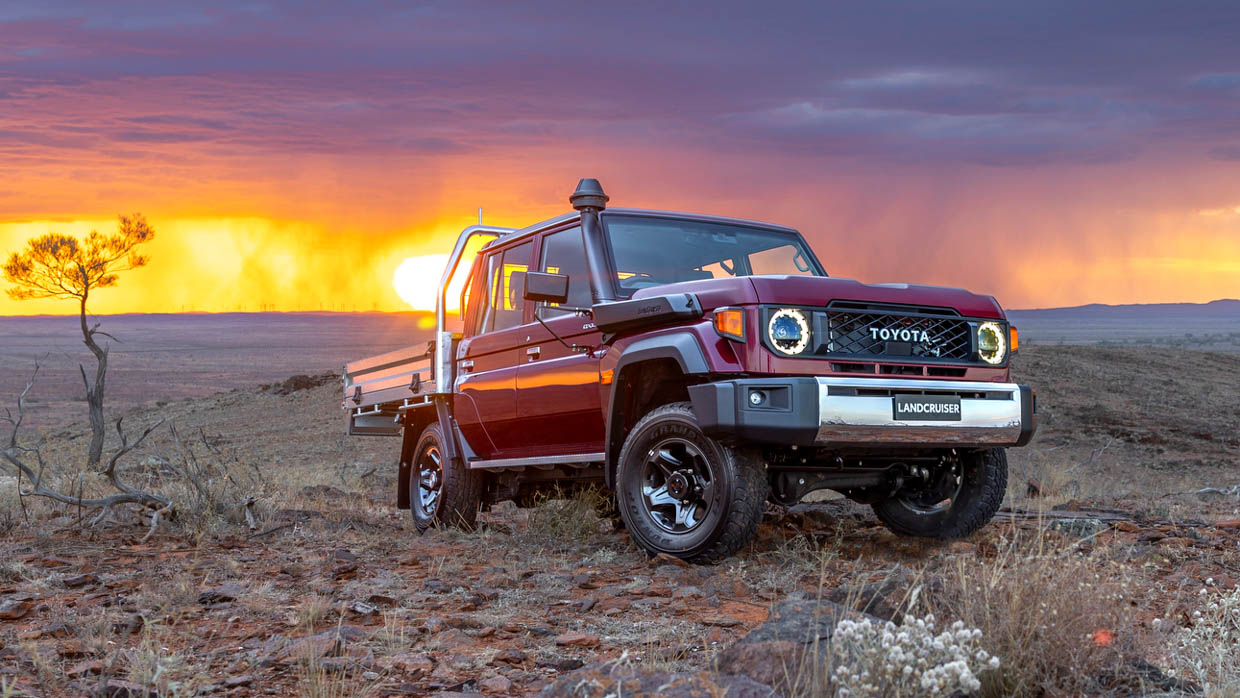
It’s disappointing that Toyota hasn’t addressed one of the most common criticisms from fans and corrected the rear track to match the front or unified the safety equipment across the range, but hopefully these will be introduced in an update in the near future.
In 2024, the 70 Series is better than it’s ever been, and while it’s not the vehicle everyone needs, it’s certainly the vehicle that many, many people want in their driveway.
About Chasing cars
Chasing Cars reviews are 100% independent.
Because we are powered by Budget Direct Insurance, we don’t receive advertising or sales revenue from car manufacturers.
We’re truly independent – giving you Australia’s best car reviews.
The estimate provided does not take into account your personal circumstances but is intended to give a general indication of the cost of insurance, in order to obtain a complete quote, please visit www.budgetdirect.com.au. Estimate includes 15%^ online discount.
^Conditions Apply
Budget Direct Insurance arranged by Auto & General Services Pty Ltd ACN 003 617 909(AGS) AFSL 241 411, for and on behalf of the insurer, Auto & General Insurance Company Limited(ABN 42 111 586 353, AFSL 285 571).Because we don’t know your financial needs, we can’t advise you if this insurance will suit you. You should consider your needs and the Product Disclosure Statement before making a decision to buy insurance. Terms and conditions apply.
Indicative quote based on assumptions including postcode , 40 year old male with no offences, licence suspensions or claims in the last 5 years, a NCD Rating 1 and no younger drivers listed. White car, driven up to 10,000kms a year, unfinanced, with no modifications, factory options and/or non-standard accessories, private use only and garaged at night.
^Online Discounts Terms & Conditions
1. Discounts apply to the premium paid for a new Budget Direct Gold Comprehensive Car Insurance, Third Party Property Only or Third Party Property, Fire & Theft Insurance policy initiated online on or after 29 March 2017. Discounts do not apply to optional Roadside Assistance.
2. Discounts do not apply to any renewal offer of insurance.
3. Discounts only apply to the insurance portion of the premium. Discounts are applied before government charges, taxes, levies and fees, including instalment processing fees (as applicable). The full extent of discounts may therefore be impacted.
4. We reserve the right to change the offer without notice.